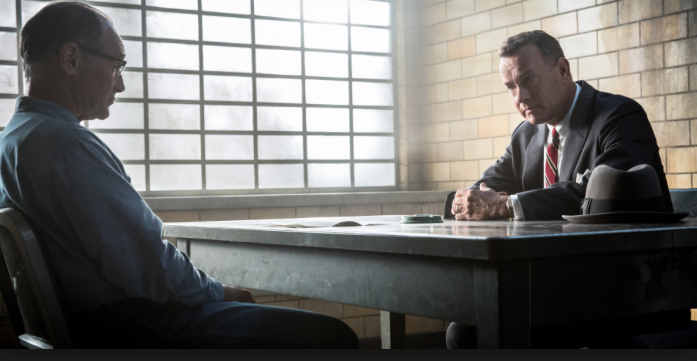Film Review: 'Bridge Of Spies'

Instead, the devil was in the details. Set against the backdrop of the Cold War, a meticulous manipulation of mise en scene and close-ups gave viewers an inside look into the mindsets of the characters and the Red-Scare paranoia that gripped a nation.
Hanks plays James B. Donovan, an insurance lawyer selected to defend suspected Soviet spy Rudolph Abel (Mark Rylance). He is initially reluctant to take the case, but viewers can sense his excitement over the challenging prospect as he tries to convince his irritated wife why he should (when really, he is trying to explain why he wants) to take it on.
Despite knowing he will be the second most-hated man in America, Donovan is determined to give Abel a strong defense to earn him a fair trial. When appealing to the U.S. Supreme Court, Donovan essentially argues that treating Abel as they would any citizen with constitutional rights, even a suspected enemy, prevents the United States from stooping to the level of its enemies across the pond.
Through this one speech, which probably took up no more than 30 seconds of the movie’s 140-minute running time, filmmakers poked at a very big theme in American history: the challenge of maintaining constitutional and democratic constancy during times of war—whether that war is hot (Iraq, Afghanistan) or cold (the Soviet Union).
The film skipped over the trial and all of the dramatic antics of an on-screen courtroom. Instead, viewers see the aftermath and Donovan’s persuasion of a judge to reduce Abel’s death sentence to life imprisonment in case the U.S. needs leverage in the future. Indeed, when U.S. spy pilot Francis Gary Powers is captured in Soviet territory, Donovan’s foresight wins him the mission of negotiating an exchange.
With very muted, drab tones, the film reflects the dark, paranoia-stricken times of the Cold War. In fact, in one scene, the characters’ clothes perfectly blend with the gray walls behind them.
Yet the juxtaposed scenes between the Soviet and American prisoners shed a bright but perhaps artificially induced light on America, portraying the Russians as evil, rough barbarians who torture Powers with sleep deprivation and the Americans as civilized, up-standing citizens who only gently probe Abel awake.
The film picks up when Abel tells Donovan the story of “Postoyannaya Chelovek” or “the Standing Man,a” a figure from his childhood who, despite being beaten several times, continued to get back up.
“They hit him harder—still, he got back to his feet,” Abel says, his cigarette placed steadily between his fingers. “I think because of this they let him live.”
The camera then shifts to Hanks in a low-angle shot, hinting at not only his moral superiority in trying to treat everyone with a sense of humanity, but also his subsequent heroic journey to becoming “the Standing Man.”
Despite his mission to retrieve Powers, Donovan puts everything on the line to also get back Frederic Pryor, an economics student who found himself on the wrong side of the wall.
Hanks, ever the consistent professional, gives an outstanding performance, portraying Donovan as a fish out of water who, remarkably, still finds a way to swim. Whether he is plowing through the snow-littered roads of Eastern Germany after crossing the Berlin Wall in a cashmere coat, negotiating with a high-level KGB official posing as a Second Secretary, or telling a lowly secretary to inform his boss of a 2-for-1 exchange ultimatum with his nose dripping from a cold, Hanks portrays Donovan as a man of moral constancy who refuses to discard traits he believes makes him an American, even when his country does.
As Donovan finds himself lying across his bed, drained and exhausted, it is up to the audience to decide whether he really is “the Standing Man.”
At its core, “Bridge of Spies” is a patriotic film, but it reminds viewers of the dangers that come with surrendering adherence to constitutional rights and of the values that made America great in the past and can perhaps do so again.
Reach Contributor Agnessa Kasumyan here.



